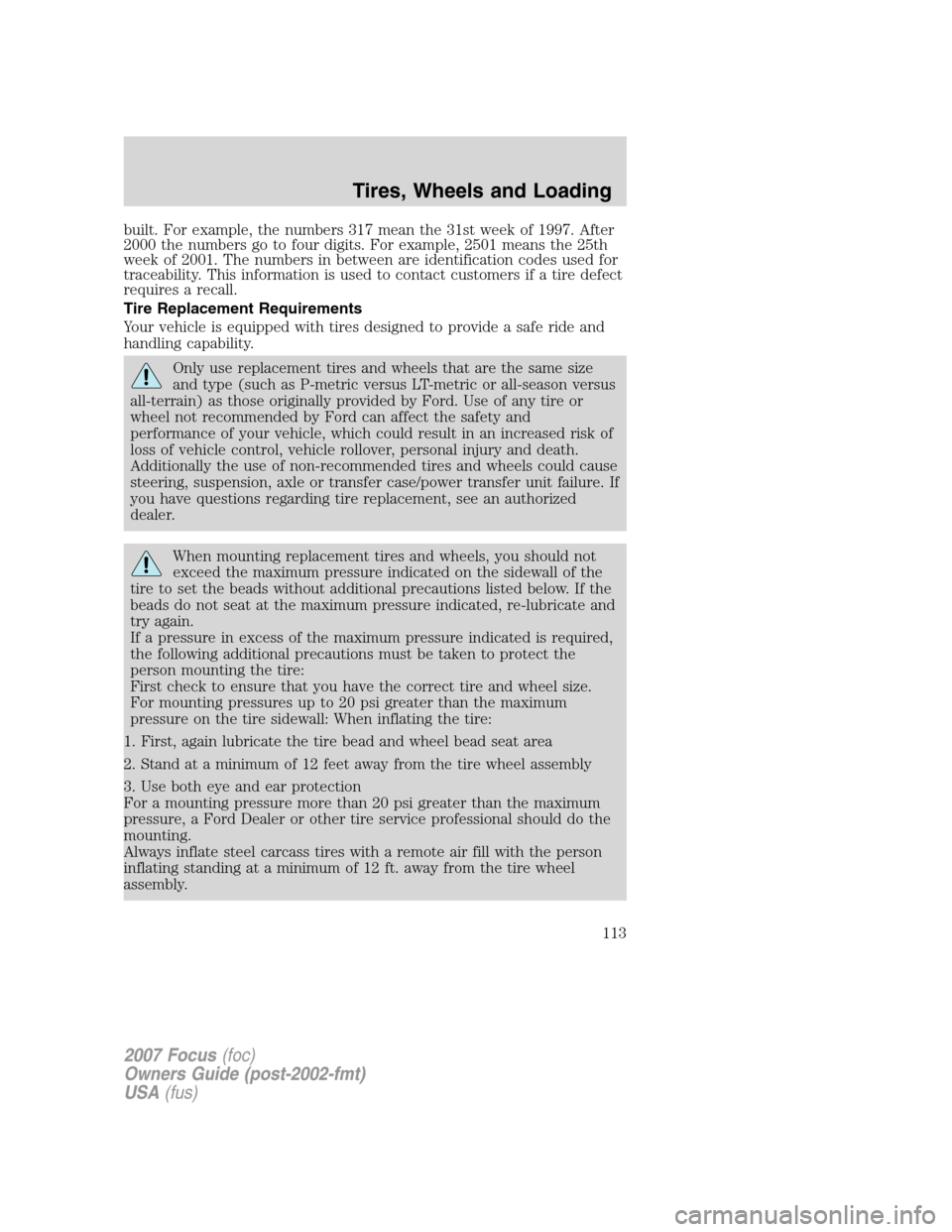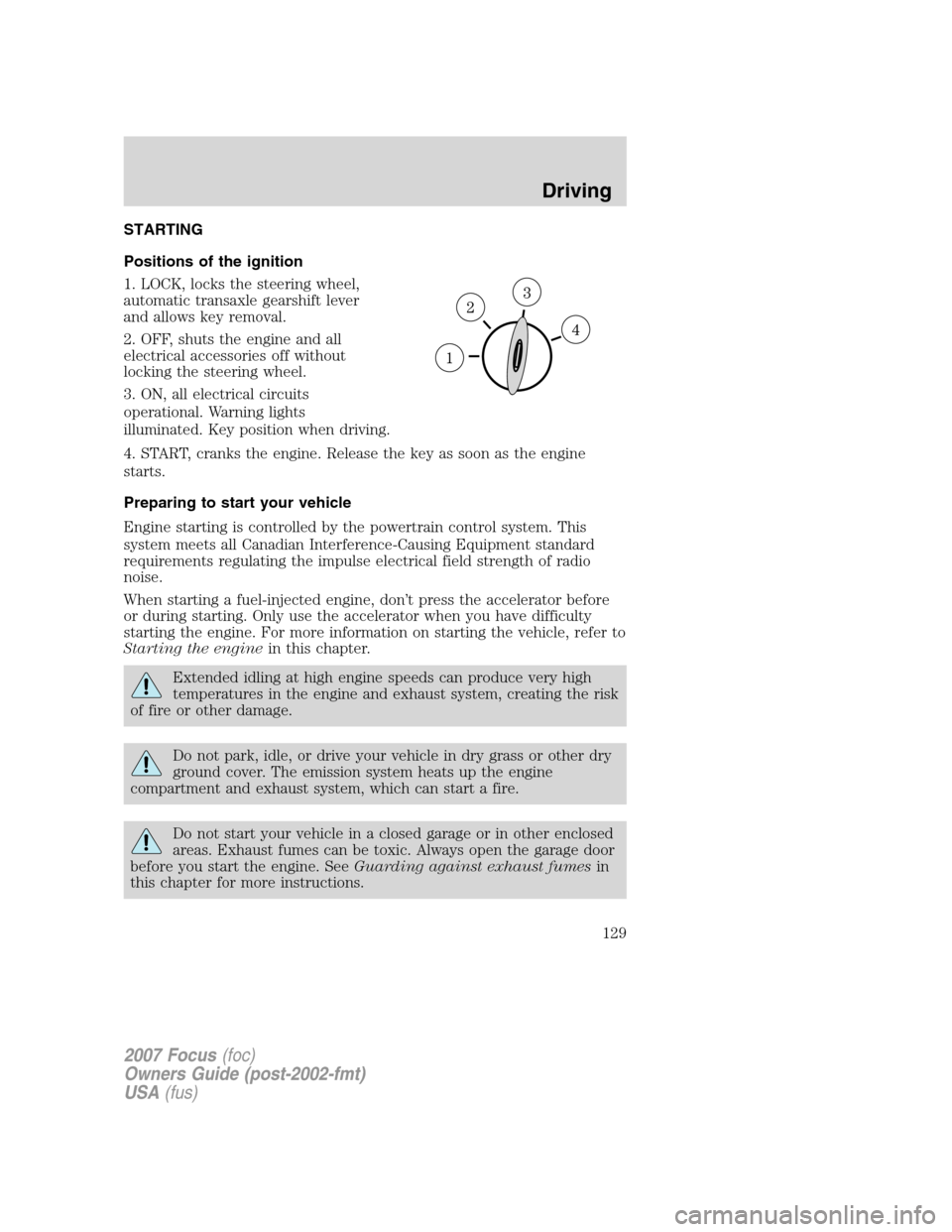Page 1 of 224
Introduction 4
Instrument Cluster 10
Warning lights and chimes 10
Gauges 14
Entertainment Systems 16
AM/FM stereo with single CD 16
AM/FM stereo with in-dash six CD 20
Climate Controls 25
Heater only 25
Manual heating and air conditioning 26
Rear window defroster 28
Lights 29
Headlamps 29
Turn signal control 32
Bulb replacement 32
Driver Controls 40
Windshield wiper/washer control 40
Steering wheel adjustment 41
Power windows 43
Mirrors 44
Speed control 45
Remote audio controls 48
Moon roof 48
Locks and Security 53
Keys 53
Locks 53
Anti-theft system 60
Table of Contents
1
2007 Focus(foc)
Owners Guide (post-2002-fmt)
USA(fus)
Page 9 of 224
Vehicle Symbol Glossary
Power Windows
Front/Rear
Power Window Lockout
Child Safety Door
Lock/UnlockInterior Luggage
Compartment Release
Symbol
Panic AlarmEngine Oil
Engine CoolantEngine Coolant
Temperature
Do Not Open When HotBattery
Avoid Smoking, Flames,
or SparksBattery Acid
Explosive GasFan Warning
Power Steering FluidMaintain Correct Fluid
LevelMAX
MIN
Emission SystemEngine Air Filter
Passenger Compartment
Air FilterJack
Check Fuel CapLow Tire Pressure
Warning
2007 Focus(foc)
Owners Guide (post-2002-fmt)
USA(fus)
Introduction
9
Page 113 of 224

built. For example, the numbers 317 mean the 31st week of 1997. After
2000 the numbers go to four digits. For example, 2501 means the 25th
week of 2001. The numbers in between are identification codes used for
traceability. This information is used to contact customers if a tire defect
requires a recall.
Tire Replacement Requirements
Your vehicle is equipped with tires designed to provide a safe ride and
handling capability.
Only use replacement tires and wheels that are the same size
and type (such as P-metric versus LT-metric or all-season versus
all-terrain) as those originally provided by Ford. Use of any tire or
wheel not recommended by Ford can affect the safety and
performance of your vehicle, which could result in an increased risk of
loss of vehicle control, vehicle rollover, personal injury and death.
Additionally the use of non-recommended tires and wheels could cause
steering, suspension, axle or transfer case/power transfer unit failure. If
you have questions regarding tire replacement, see an authorized
dealer.
When mounting replacement tires and wheels, you should not
exceed the maximum pressure indicated on the sidewall of the
tire to set the beads without additional precautions listed below. If the
beads do not seat at the maximum pressure indicated, re-lubricate and
try again.
If a pressure in excess of the maximum pressure indicated is required,
the following additional precautions must be taken to protect the
person mounting the tire:
First check to ensure that you have the correct tire and wheel size.
For mounting pressures up to 20 psi greater than the maximum
pressure on the tire sidewall: When inflating the tire:
1. First, again lubricate the tire bead and wheel bead seat area
2. Stand at a minimum of 12 feet away from the tire wheel assembly
3. Use both eye and ear protection
For a mounting pressure more than 20 psi greater than the maximum
pressure, a Ford Dealer or other tire service professional should do the
mounting.
Always inflate steel carcass tires with a remote air fill with the person
inflating standing at a minimum of 12 ft. away from the tire wheel
assembly.
2007 Focus(foc)
Owners Guide (post-2002-fmt)
USA(fus)
Tires, Wheels and Loading
113
Page 129 of 224

STARTING
Positions of the ignition
1. LOCK, locks the steering wheel,
automatic transaxle gearshift lever
and allows key removal.
2. OFF, shuts the engine and all
electrical accessories off without
locking the steering wheel.
3. ON, all electrical circuits
operational. Warning lights
illuminated. Key position when driving.
4. START, cranks the engine. Release the key as soon as the engine
starts.
Preparing to start your vehicle
Engine starting is controlled by the powertrain control system. This
system meets all Canadian Interference-Causing Equipment standard
requirements regulating the impulse electrical field strength of radio
noise.
When starting a fuel-injected engine, don’t press the accelerator before
or during starting. Only use the accelerator when you have difficulty
starting the engine. For more information on starting the vehicle, refer to
Starting the enginein this chapter.
Extended idling at high engine speeds can produce very high
temperatures in the engine and exhaust system, creating the risk
of fire or other damage.
Do not park, idle, or drive your vehicle in dry grass or other dry
ground cover. The emission system heats up the engine
compartment and exhaust system, which can start a fire.
Do not start your vehicle in a closed garage or in other enclosed
areas. Exhaust fumes can be toxic. Always open the garage door
before you start the engine. SeeGuarding against exhaust fumesin
this chapter for more instructions.
2007 Focus(foc)
Owners Guide (post-2002-fmt)
USA(fus)
Driving
129
Page 135 of 224

The Traction Control�switch is
located on the center console, by
the gearshift lever. The Traction
Control�system will automatically
turn on every time the ignition is
turned off and on.
If you should become stuck in snow
or ice or on a very slippery road surface, try switching the Traction
Control�system off by pressing the switch. This may allow excess wheel
spin to “dig” the vehicle out and enable a successful “rocking” maneuver.
If you want to turn off the Traction Control�system be aware that, for
safety reasons, the switch must be pressed and held for at least one
second before the system is turned off. To re-engage the Traction
Control�system, the button must again be held for at least one second.
If a system fault is detected, the traction control active light will
illuminate, the Traction Control�button will not turn the system on or
off and your vehicle should be serviced by an authorized dealer.
STEERING
To help prevent damage to the power steering system:
•Never hold the steering wheel at its furthest turning points (until it
stops) for more than a few seconds when the engine is running.
•Do not operate the vehicle with a low power steering pump reservoir
fluid level (below the MIN mark on the reservoir).
•Some noise is normal during operation. If the noise is excessive, check
for low power steering pump fluid level before seeking service by your
authorized dealer.
•Heavy or uneven steering efforts may be caused by low power steering
pump fluid level. Check for low power steering pump fluid level before
seeking service by your authorized dealer.
•Do not fill the power steering pump reservoir above the MAX mark on
the reservoir, as this may result in leaks from the reservoir.
If the power steering system breaks down (or if the engine is turned
off), you can steer the vehicle manually, but it takes more effort.
If the steering wanders or pulls, check for:
•an improperly inflated tire
•uneven tire wear
•loose or worn suspension components
2007 Focus(foc)
Owners Guide (post-2002-fmt)
USA(fus)
Driving
135
Page 146 of 224
Passenger compartment fuse panel
The fuse panel is located below and to the left of the steering wheel by
the brake pedal. Remove the CD stowage box to access the fuses.
To remove a fuse, use the fuse puller tool provided on the power
distribution box cover located in the engine compartment.
The fuses are coded as follows.
Fuse/Relay
LocationFuse Amp
RatingPassenger Compartment Fuse
Panel Description
R17 — Starter relay
R18 — Not used
R19 — Not used
R20 — Not used
R21 — Daytime running lamps
R22 — Not used
R23 — Not used
2007 Focus(foc)
Owners Guide (post-2002-fmt)
USA(fus)
Roadside Emergencies
146
Page 151 of 224

Fuse/Relay
LocationFuse Amp
RatingPower Distribution Box
Description
R10 — Cooling fan relay
R11 — Not used
R12 — Not used
R13 — Not used
R14 — Not used
R15 — Air pump motor relay
R16 — Not used
D1 — Not used
D2 — Not used
D3 — A/C clutch diode
D4 — Not used
CHANGING A FLAT TIRE
If you get a flat tire while driving:
•do not brake heavily.
•gradually decrease the vehicle’s speed.
•hold the steering wheel firmly.
•slowly move to a safe place on the side of the road.
The use of tire sealants may damage your tires.
Dissimilar spare tire/wheel information
Failure to follow these guidelines could result in an increased
risk of loss of vehicle control, injury or death.
If you have a dissimilar spare tire/wheel, then it is intended for
temporary use only. This means that if you need to use it, you should
replace it as soon as possible with a road tire/wheel that is the same size
and type as the road tires and wheels that were originally provided by
Ford. If the dissimilar spare tire or wheel is damaged, it should be
replaced rather than repaired.
A dissimilar spare tire/wheel is defined as a spare tire and/or wheel that
is different in brand, size or appearance from the road tires and wheels
and can be one of three types:
2007 Focus(foc)
Owners Guide (post-2002-fmt)
USA(fus)
Roadside Emergencies
151
Page 179 of 224
IDENTIFYING COMPONENTS IN THE ENGINE COMPARTMENT
2.0L/2.3L I4 Engines
1. Windshield washer fluid reservoir
2. Engine coolant reservoir
3. Engine oil filler cap
4. Brake/Clutch fluid reservoir
5. Power distribution box
6. Battery
7. Automatic transaxle fluid dipstick (if equipped)
8. Engine oil dipstick
9. Power steering fluid reservoir
2007 Focus(foc)
Owners Guide (post-2002-fmt)
USA(fus)
Maintenance and Specifications
179